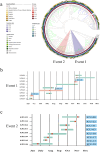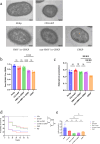Nosocomial transmission, adaption and clinical outcomes of carbapenem-resistant hypervirulent Klebsiella pneumoniae
- PMID: 40597682
- PMCID: PMC12219914
- DOI: 10.1186/s12866-025-04096-z
Nosocomial transmission, adaption and clinical outcomes of carbapenem-resistant hypervirulent Klebsiella pneumoniae
Abstract
Background: Carbapenem-resistant hypervirulent Klebsiella pneumoniae (CR-HvKp) poses a significant threat in healthcare settings. This study investigates the nosocomial transmission dynamics, adaptive phenotypes, and clinical outcomes of CR-HvKp with different evolutionary patterns.
Methods: A genomic analysis of 2,002 Klebsiella pneumoniae isolates collected from a major teaching hospital in China was performed to identify convergent isolates. Epidemiological features, including CR-HvKp nosocomial transmission, were assessed. Selected isolates underwent phenotypic testing to evaluate adaptive traits. Clinical outcomes were analyzed retrospectively using electronic medical records.
Results: A total of 127 CR-HvKp were characterized, with ST11-KL64 hv-CRKP (carbapenem resistant Klebsiella pneumoniae acquired hypervirulence) as the predominant sequence type. CR-HvKp exhibited diverse evolutionary patterns linked to nosocomial transmission, particularly in the ICU. ST11-KL64 hv-CRKP demonstrated robust transmission within ICU settings. Compared to CRKP, hv-CRKP showed enhanced in vitro competitiveness and superior immune evasion. CR-HvKp infections were significantly associated with higher mortality rates, especially involved in sepsis or septic shock (P < 0.0001).
Conclusion: The ST11-KL64 hv-CRKP clonal complex is highly prevalent in CR-HvKp and demonstrates significant nosocomial transmission, particularly within ICU settings. Timely and effective sepsis management is critical to improving survival outcomes in CR-HvKp infections. Continuous genomic surveillance is imperative to control the spread of these pathogens.
Keywords: Adaptation; Carbapenem-resistant hypervirulent Klebsiella pneumoniae; Clinical outcomes; Evolutionary patterns; Nosocomial transmission.
© 2025. The Author(s).
Conflict of interest statement
Declarations. Ethics approval and consent to participate: This study was approved by the Ethics Committee of Xiangya Hospital of Central South University (ID 202212295, Changsha, Hunan Province, China). Because this was a retrospective study involving the collection of KP strains and anonymized clinical data from patients, the Ethics Committee of Xiangya Hospital of Central South University passed the exemption condition for informed consent. Meanwhile, the animal experiments in the study were approved by the Experimental Animal Ethics Committee of Xiangya Hospital of Central South University under the approval number 202409155. Specifically, following bacterial inoculation and before surgery, mice are anaesthetised with 0.1% pentobarbital at a dose of 0.15 mg per 20 g of body weight. At this point, they are unconscious and insensate to pain. Subsequently, they are euthanised by rapid cervical dislocation. This method was selected as it adheres to ethical guidelines for animal welfare, ensuring a humane and rapid euthanasia process with minimal distress to the animals. It is also a widely accepted technique in research settings.We declare that our research strictly adheres to the Declaration of Helsinki. Consent for publication: Not applicable. Competing interests: The authors declare no competing interests.
Figures





Similar articles
-
Emergence of ST11-KL64 carbapenem-resistant hypervirulent Klebsiella Pneumoniae isolates harboring blaKPC-2 and iucA from a tertiary teaching hospital in Western China.BMC Infect Dis. 2025 Jul 1;25(1):880. doi: 10.1186/s12879-025-11241-6. BMC Infect Dis. 2025. PMID: 40596916 Free PMC article.
-
Molecular and epidemiological characterization of carbapenem-resistant hypervirulent Klebsiella pneumoniae in Huaian, China (2022-2024): a retrospective study.Front Cell Infect Microbiol. 2025 Jun 4;15:1569004. doi: 10.3389/fcimb.2025.1569004. eCollection 2025. Front Cell Infect Microbiol. 2025. PMID: 40535540 Free PMC article.
-
Epidemiological, phenotypic and genotypic characteristics difference of hypervirulent and carbapenem-resistant Klebsiella pneumoniae with different capsular serotypes.J Microbiol Immunol Infect. 2025 Aug;58(4):444-454. doi: 10.1016/j.jmii.2025.02.010. Epub 2025 Feb 28. J Microbiol Immunol Infect. 2025. PMID: 40055131
-
The mechanisms of resistance, epidemiological characteristics, and molecular evolution of carbapenem-resistant hypervirulent Klebsiella pneumoniae.Lab Med. 2025 Jul 11;56(4):323-335. doi: 10.1093/labmed/lmae110. Lab Med. 2025. PMID: 40072365 Review.
-
"Global divide in carbapenem resistance and hypervirulence of Klebsiella pneumonia: comparing trends in India and developed nations"- a comprehensive review.J Antibiot (Tokyo). 2025 Jul;78(8):457-471. doi: 10.1038/s41429-025-00833-8. Epub 2025 Jun 3. J Antibiot (Tokyo). 2025. PMID: 40461635 Review.
References
-
- Shrivastava S, Shrivastava P, Ramasamy J. World health organization releases global priority list of antibiotic-resistant bacteria to guide research, discovery, and development of new antibiotics. J Med Soc. 2018;32(1):76–7. 10.4103/jms.jms_25_17.
-
- Wang M, Earley M, Chen L, Hanson BM, Yu Y, Liu Z, et al. Clinical outcomes and bacterial characteristics of carbapenem-resistant Klebsiella pneumoniae complex among patients from different global regions (CRACKLE-2): a prospective, multicentre, cohort study. Lancet Infect Dis. 2022;22(3):401–12. 10.1016/s1473-3099(21)00399-6. - PMC - PubMed
-
- Zou H, Zhou Z, Berglund B, Zheng B, Meng M, Zhao L, et al. Persistent transmission of carbapenem-resistant, hypervirulent Klebsiella pneumoniae between a hospital and urban aquatic environments. Water Res. 2023;242:120263. 10.1016/j.watres.2023.120263. - PubMed
MeSH terms
Substances
Grants and funding
- 2018YFC2000203/National Key Research and Development Program of China
- 2018YFC2000203/National Key Research and Development Program of China
- 2018YFC2000203/National Key Research and Development Program of China
- 2018YFC2000203/National Key Research and Development Program of China
- 2018YFC2000203/National Key Research and Development Program of China
LinkOut - more resources
Full Text Sources

